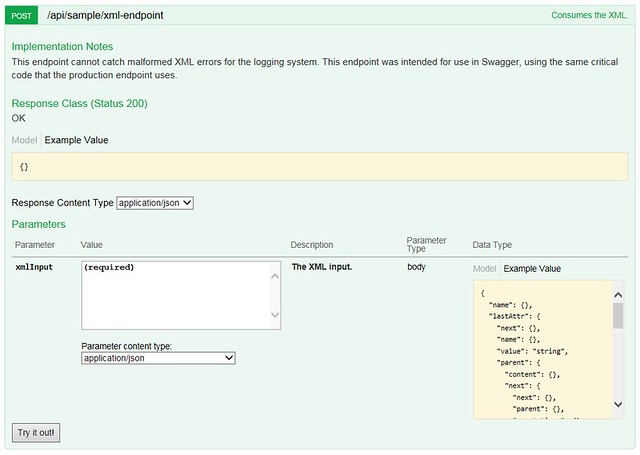Using Swashbuckle to Support Swaggerfied XML Production and Consumption
Every ASP.NET NuGet package that I have used before Swashbuckle spoiled me with just working out of the box and/or having decent documentation. When I used ELMAH (before Application Insights), I felt that it just worked. Autofac gives me that same feeling as well (in spite of some drama). My point is that Swashbuckle really stands out due to my particular approach to the technology.
My approach (due to the demands of my day job) is the need to consume/produce XML. I am deliberately using consume/produce, by the way, to align with produces/consumes of the Swagger Specification. So let’s take a look at the default Swagger UI for an XML endpoint auto-generated by version 5.5.3 of Swashbuckle:
It took me awhile to notice the obvious: Swashbuckle is biased toward JSON. This makes perfect sense until we go back to XML. Here is the ASP.NET Web API controller method that Swashbuckle is working with:
/// <summary>
/// Consumes the XML.
/// </summary>
/// <param name="xmlInput">The XML input.</param>
/// <returns></returns>
/// <remarks>
/// This endpoint cannot catch malformed XML errors for the logging system.
/// This endpoint was intended for use in Swagger,
/// using the same critical code that the production endpoint uses.
/// </remarks>
[HttpPost]
[Route("xml-endpoint")]
public IHttpActionResult ConsumeXml([FromBody]XElement xmlInput)
{
return this.Ok<XElement>(xmlInput.ToResponseDocument());
}
When I mention that ToResponseDocument() in the method body above is just an some custom extension method that I wrote, we can disregard the method body. Swashbuckle is pretty much doing that as well. In order to get Swashbuckle to tell Swagger to consume/produce XML exclusively, we need to add my custom method attribute, SwaggerContentType, and my class implementing IOperationFilter (in Swashbuckle.Core), SwaggerContentTypeOperationFilter, mediated by entries in SwaggerConfig.cs.
We can see what our controller method looks like with SwaggerContentType declaring Swagger production and consumption:
/// <summary>
/// Consumes the XML.
/// </summary>
/// <param name="xmlInput">The XML input.</param>
/// <returns></returns>
/// <remarks>
/// This endpoint cannot catch malformed XML errors for the logging system.
/// This endpoint was intended for use in Swagger,
/// using the same critical code that the production endpoint uses.
/// </remarks>
[HttpPost]
[Route("xml-endpoint")]
[SwaggerContentType(mimeType: MimeTypes.ApplicationXml,
IsExclusive = true,
IsConsumption = false,
Tag = nameof(MyController.ConsumeXml))]
[SwaggerContentType(mimeType: MimeTypes.ApplicationXml,
IsExclusive = true,
IsConsumption = true,
MethodParameterName = "xmlInput",
Tag = nameof(MyController.ConsumeXml))]
public IHttpActionResult ConsumeXml([FromBody]XElement xmlInput)
{
return this.Ok<XElement>(xmlInput.ToResponseDocument());
}
With these attributes (and their backing IOperationFilter classes), we can now see Swashbuckle generating improved Swagger:
To make this happen, SwaggerContentTypeOperationFilter pulls our custom attributes by LINQ-querying ApiDescription. We can use this custom attribute data to edit an instance of Swashbuckle’s Operation class (which is on line 99 of SwaggerDocument.cs class in the current master). My GitHub Gist showsSwaggerContentTypeOperationFilterapplying these changes, handling Swagger consumption and production.
Once all of these classes are in place and the method attributes are adorning, we can add this mediating line to that GlobalConfiguration.Configuration.EnableSwagger lambda expression in SwaggerConfig.cs jam-packed with comments:
// Similar to Schema filters, Swashbuckle also supports Operation and Document filters:
//
// Post-modify Operation descriptions once they've been generated by wiring up one or more
// Operation filters.
//
//c.OperationFilter<AddDefaultResponse>();
//
// Set filter to apply Custom Content Types to operations
c.OperationFilter<SwaggerContentTypeOperationFilter>();
I notice that all of this work has no control over the “Example Value” XML shown in the Swagger UI. I think this is controlled by the Swagger Definitions Object. Assuming that a newer version of Swashbuckle will not get this working out of the box for XML, I will have to come back to this later.

